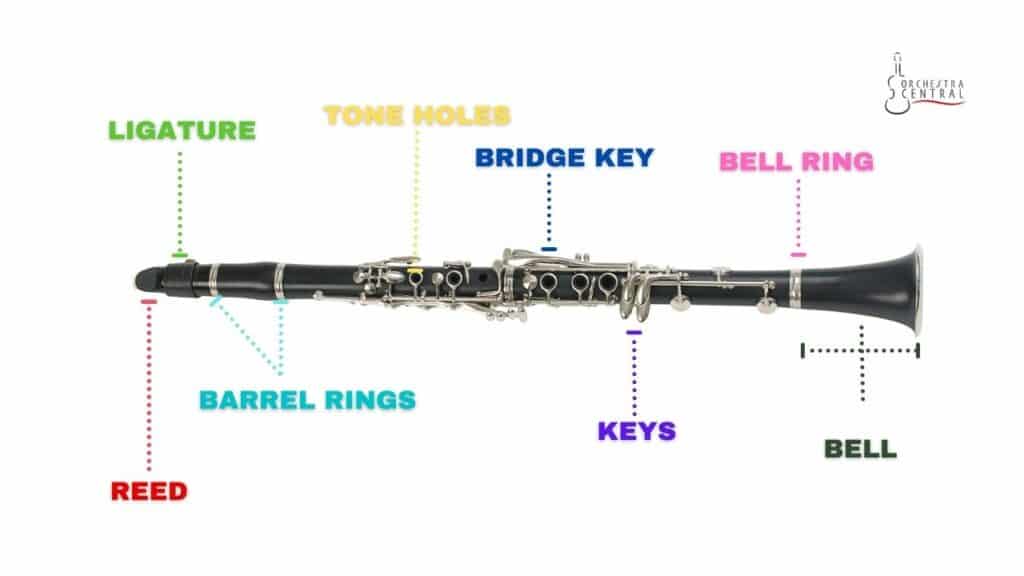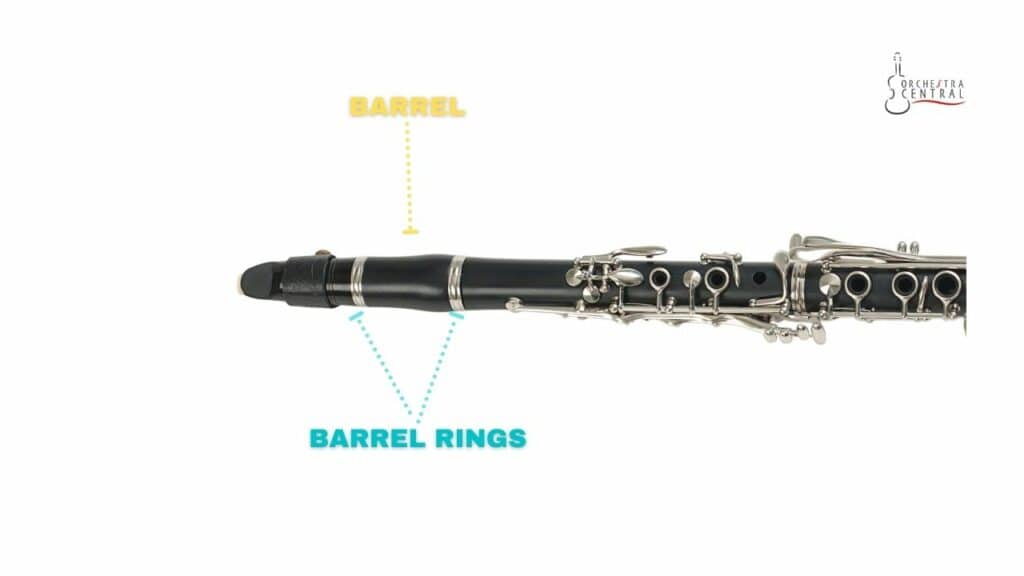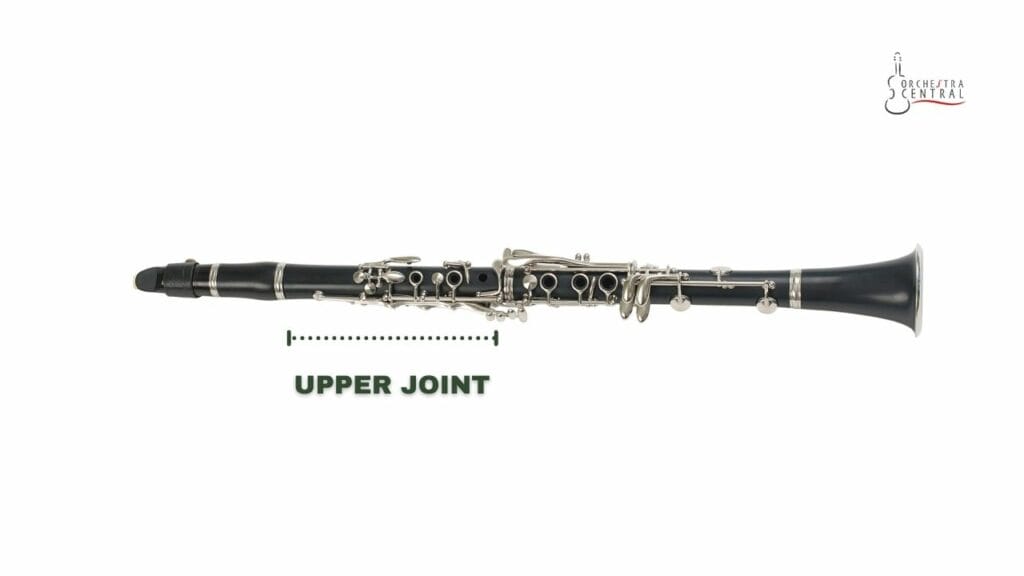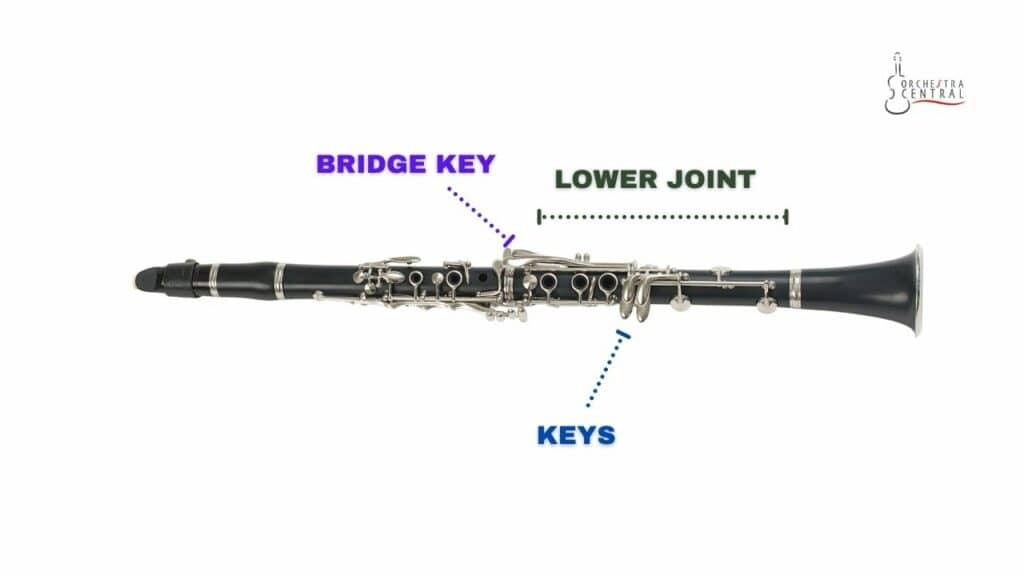The clarinet might seem intimidating with all of its rods and keys. Luckily, in this article, we’ll discuss the different clarinet parts and the purpose of each one.
Anatomy of a Clarinet

Mouthpiece

A clarinet’s mouthpiece, which can either be plastic or hard rubber, creates the initial sound wave that sets the air column inside the instrument’s body into vibration. It also helps shape and focus this sound wave as it exits the device. Doing so allows for control over pitch, volume, and tone color. Depending on your music style, you may use different types of mouthpieces to achieve specific tonal characteristics.
Tip: Proper care and mouthpiece maintenance are crucial for good sound quality and response.
Reed

The reed is a thin strip attached to a clarinet’s mouthpiece. It’s responsible for creating the clarinet’s unique sound. Without it, there wouldn’t be any music emanating from this beautiful instrument.
This clarinet part can be made from either reed cane or synthetic material. It also comes in various cuts to cater to different playing styles.
Fact: A player’s choice of reed also affects tone quality, projection ability, and ease of playing.
Ligature

A ligature holds the reed against the mouthpiece, allowing for proper sound production. Two adjustable screws keep it in place because any slight movement or adjustment can significantly affect the clarinet’s sound and tone.
You should also consider the materials and designs of ligatures as they can also affect how the instrument sounds.
Similar to the mouthpiece, ligatures are typically composed of metal but come in many styles. You can find all ligatures ranging from:
- Plastic
- Leather
- String
- Gold
- Nickel plated
Barrel

The barrel fine-tunes the overall pitch and intonation of the instrument. It is an adjustable extension between the mouthpiece and upper joint, letting you change the clarinet’s air column length for more accurate tuning across different registers.
The barrel’s taper (the inside shape of the barrel), material, and length can also impact tone, color, and projection. Essentially, this clarinet part enables you to deliver clear, precise notes throughout your entire range.
One may choose from a variety of taper shapes:
- Straight
- Double
- Standard
- Reverse
Tip: The barrel’s ability to move the clarinet away from the top joint and alter the instrument’s tune is also crucial.
Barrel Rings
The barrel rings adds an extra layer of stability, helping to maintain the correct pitch without compromising tone quality.
Tenon corks may experience significant pressure because the barrel connects to the mouthpiece and upper joint. Barrell rings are fastened to the ends of the barrel to prevent the wood from splitting due to the pressure of the tenon.
Tip: Loose barrel rings might indicate the barrel’s wood is overly dry and brittle.
Upper Joint

The body of the clarinet is divided into two joints – the upper joint and the lower joint. You will find the upper joint after the second barrel ring. This portion, which is where you put your left hand over, consists of two clarinet parts – the register key and the tone holes.
Fun Fact: If you want to know either the manufacturer or the serial number of your clarinet, check the upper joint.
Register Key
The register key allows players to produce notes in the higher octave range since it redirects an air column through an additional hole that makes higher-pitched notes than the standard fingerings.
Clarinets have different register keys based on their design and range options, including plateau-style registers, which are best for beginners. On the other hand, rectangular-shaped registers have higher fit variability for advanced musicians, allowing greater flexibility.
Overall, the register key, which you can find on the back of the upper joint and is typically pressed with your left thumb, will allow you to master the full potential of the clarinet sound spectrum.
Tone Holes
With tone holes, you can play more notes by changing the air column length inside the instrument. You can adjust pitch fluctuations or add vibrato by opening or closing these holes. As a result, tone holes enhance the depth and variety of sounds produced, giving you greater control over your performances.
Lower Joint

After the upper joint, you will find the lower joint. It consists of clarinet parts that are critical to how you control the sound of the instrument.
Bridge Key
Due to the instrument’s design, certain notes tend to sound weak and out of tune when played with conventional fingerings. A bridge key opens a tone hole, allowing for a more accurate pitch and fuller sound.
The bridge key also enables greater flexibility and control for musicians who demand precision and expression. Though not all clarinets have this feature, it is considered a standard part of professional models and enhances versatility.
Keys
Keys enable you to control the instrument’s intonation by producing different notes and executing specific techniques. The keys help change the length of the vibrating air column and thus generate various pitches. Additionally, they allow access to a broader range of notes than what is possible with natural tones alone.
Clarinetists use keys to play staccato and legato passages, trills, glissandos, and other ornaments. This clarinet part also helps produce higher-quality sound by correcting issues like intonation errors caused by inherent properties. Sometimes the errors occur due to the clarinet itself or variations in temperature and humidity.
Bell Ring
You will find the bell ring, a thin strip of metal that covers the upper end of the clarinet bell. It is a critical component because it protects the delicate top end of the bell. It also improves the resonance and sound projection by reducing vibrations in the clarinet’s last few millimeters.
Bell
The cone-shaped clarinet bells act like a megaphone, widening the diameter of the exit point for sound waves. It also helps regulate the back pressure within the clarinet parts. Without a bell, the clarinet would produce a muffled and dull sound.
Like other parts of the clarinet, you can get the bell in different materials, lengths, and even flares to suit your preferences.
Final Thoughts
We hope that clarifies the different parts of a clarinet. Remember, bass clarinet parts might make the instrument seem complicated to a novice player. Still, with little practice and understanding of each component, you should be able to master the instrument in no time.
Table of Contents






